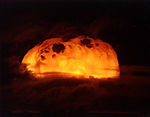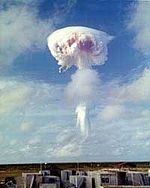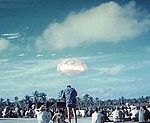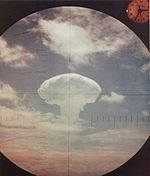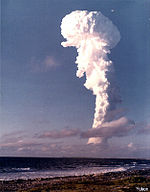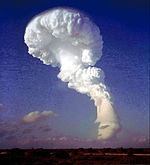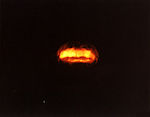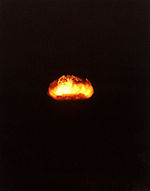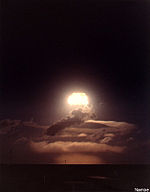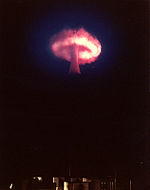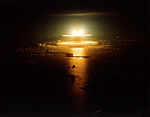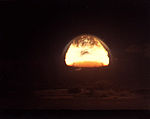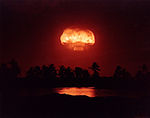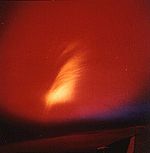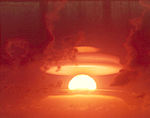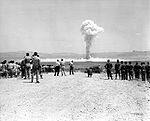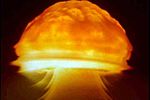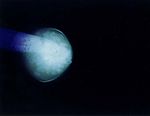- Operation Dominic I and II
-
Operation Dominic 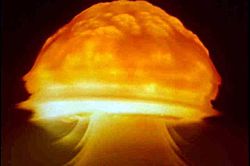
Dominic ChamaInformation Country  United States
United StatesTest site Nevada Test Site (I) / Pacific Proving Grounds (II) Period April–July 1962 Number of tests 40 Test type Atmospheric / Underwater Max. yield 8.3 Mt Navigation Previous test Operation Nougat Next test Operation Storax Operation Dominic was a series of 105 nuclear test explosions conducted in 1962 by the United States. Those conducted in the Pacific are sometimes called Dominic I. The blasts in Nevada are known as Dominic II. This test series was scheduled quickly, in order to respond in kind to the Soviet resumption of testing after the tacit 1958-1961 test moratorium. Most of these shots were conducted with free-fall bombs dropped from B-52 bomber aircraft. Twenty of these shots were to test new weapons designs; six to test weapons effects; and several shots to confirm the reliability of existing weapons. The Thor missile was also used to lift warheads into near-space to conduct high altitude nuclear explosion tests; these shots were collectively called Operation Fishbowl.[1]
Operation Dominic occurred during a period of high Cold War tension between the United States and the Soviet Union, since the Cuban Bay of Pigs Invasion had occurred not long before. Nikita Khrushchev announced the end of a three-year moratorium on nuclear testing on August 30, 1961, and Soviet tests recommenced on 1 September, initiating a series of tests that included the detonation of Tsar Bomba. President John F. Kennedy responded by authorizing Operation Dominic. It was the largest nuclear weapons testing program ever conducted by the United States, and the last atmospheric test series conducted by the U.S., as the Limited Test Ban Treaty was signed in Moscow the following year.
List
Dominic I & II Test Blasts Test Name Date Location Yield Note Image Adobe 25 April 1962 Christmas Island 190 kilotons Aztec 27 April 1962 Christmas Island 410 kilotons Arkansas 2 May 1962 Christmas Island 1090 kilotons Questa 4 May 1962 Christmas Island 670 kilotons Frigate Bird 6 May 1962 Pacific Test Range 600 kilotons Polaris A2 Missile launched from the submarine USS Ethan Allen (SSBN-608). Only operational test of a United States submarine launched ballistic missile with a live nuclear warhead. Yukon 8 May 1962 Christmas Island 100 kilotons Mesilla 9 May 1962 Christmas Island 100 kilotons Arikaree 10 May 1962 Christmas Island Unknown Muskegon 11 May 1962 Christmas Island 50 kilotons Swordfish 11 May 1962 off San Diego <20 kilotons RUR-5 ASROC from USS Agerholm (DD-826) at a range of only 4,000 yards. Encino 12 May 1962 Christmas Island 500 kilotons Swanee 14 May 1962 Christmas Island 97 kilotons Chetco 19 May 1962 Christmas Island 73 kilotons Tanana 25 May 1962 Christmas Island "Fizzled" Nambe 27 May 1962 Christmas Island 43 kilotons Bluegill 3 June 1962 Johnston Atoll "Failed" Operation Fishbowl, tracking electronics failure five minutes after launch, detonated manually 10 minutes later Alma 8 June 1962 Christmas Island 782 kilotons Truckee 9 June 1962 Christmas Island 210 kilotons Yeso 10 June 1962 Christmas Island 3 megatons Harlem 12 June 1962 Christmas Island 1.2 megatons Rinconada 15 June 1962 Christmas Island 800 kilotons Dulce 17 June 1962 Christmas Island 52 kilotons Petit 19 June 1962 Christmas Island "Failed" Starfish 20 June 1962 Johnston Atoll "Failed" Operation Fishbowl, rocket motor failure Otowi 21 June 1962 Nevada Test Site Unknown Bighorn 27 June 1962 Christmas Island 7.65 megatons Bluestone 30 June 1962 Christmas Island 1.27 megatons Sacramento 30 June 1962 Nevada Test Site Unknown Little Feller II 7 July 1962 Nevada Test Site Unknown Starfish Prime 9 July 1962 Johnston Atoll 1.4 megatons Operation Fishbowl, exoatmospheric at 400 km altitude, caused artificial aurora borealis and power outages in Hawaii Sunset 10 July 1962 Christmas Island 1 megaton Pamlico 11 July 1962 Christmas Island 3.88 megatons Successful advanced principles test of high-efficiency thermonuclear weapon, last Christmas Island airdrop Johnnie Boy 11 July 1962 Nevada Test Site 500 tons Merrimac 13 July 1962 Nevada Test Site Unknown Small Boy 14 July 1962 Nevada Test Site Unknown Little Feller I 17 July 1962 Nevada Test Site Unknown Bluegill Prime 25 July 1962 Johnston Atoll "Failed" Operation Fishbowl, detonated on launch pad by range safety officers shortly after ignition due to rocket motor failure, destroyed the Thor launch facility and contaminated it with plutonium, requiring three months of repairs and decontamination Bumping 6 October 1962 Johnston Atoll 11.3 kilotons Bluegill Double Prime 15 October 1962 Johnston Island "Failed" Operation Fishbowl, missile tumbled out of control due to failure of a booster rocket 86 seconds after launch, destroyed manually 156 seconds after launch with minor radioactive contamination of the island Chama 18 October 1962 Johnston Atoll 1.59 megatons Checkmate 20 October 1962 Johnston Atoll 7 kilotons Operation Fishbowl, high altitude nuclear explosion, 147 km altitude, XM-33 Strypi rocket with an Army Recruit booster, XW-50X1 warhead, no fireball Bluegill Triple Prime 26 October 1962 Johnston Atoll 410 kilotons Operation Fishbowl, high altitude nuclear explosion, 50 km altitude, Thor missile, W50 warhead, fireball formed, large disruption of ionosphere did not occur Calamity 27 October 1962 Johnston Atoll 800 kilotons Housatonic 30 October 1962 Johnston Atoll 8.3 megatons Kingfish 1 November 1962 Johnston Atoll 410 kilotons Operation Fishbowl, high altitude nuclear explosion, 97 km altitude, Thor missile with W-50 warhead, dramatic aurora-like effects, extensive ionosphere disruption, radio communication over central Pacific disrupted for over three hours Tightrope 4 November 1962 Johnston Atoll between 1–40 kilotons Operation Fishbowl, 21 km (69,000 ft) altitude, Nike Hercules missile with a W31 warhead, test of a missile defense system, regarded to be the last true U.S. atmospheric nuclear test References
External links
- Operation Dominic at Carey Sublette's NuclearWeaponArchive.org
- More info on U.S. testing
Categories:- 1962
- American nuclear explosive tests
- Code names
- Exoatmospheric nuclear explosive tests
- Military projects of the United States
Wikimedia Foundation. 2010.

